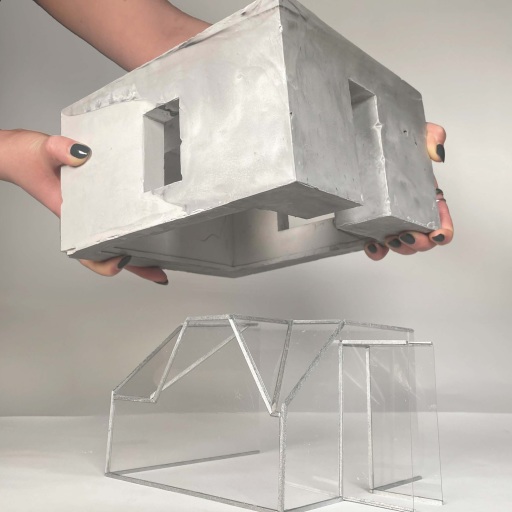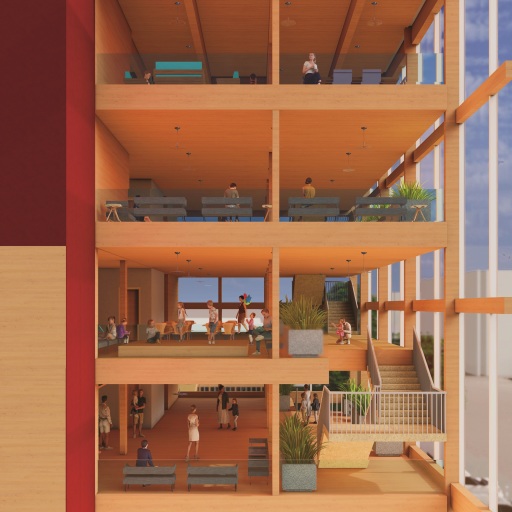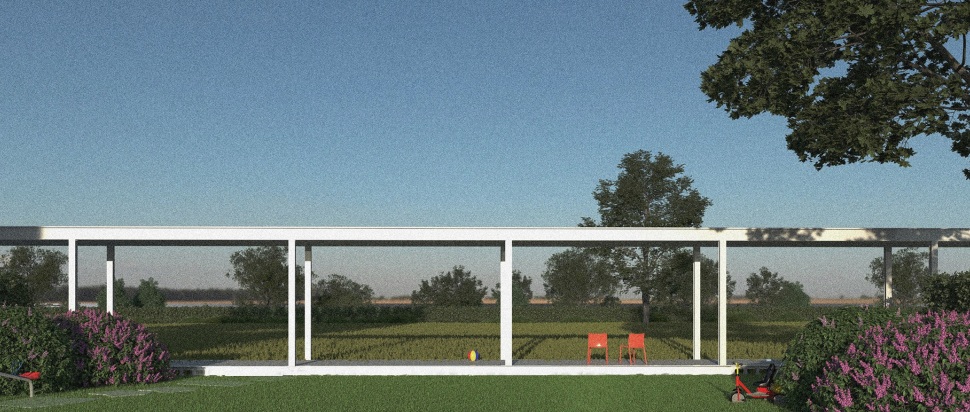GSA Degree Show 2024: Mackintosh School of Architecture
The graduates of the Mackintosh School of Architecture present a rich and diverse showcase in The Glasgow School of Art’s Bourdon Building, reimagining the landscape of Glasgow and beyond
Against the backdrop of the climate emergency, the environmental and ethical challenges faced by architects have never been more evident. Yet these graduates present a resolutely hopeful vision for the future; theirs is an ethos in which sustainability is central and ecological concerns inform the design process at every stage. They are united by an understanding of architecture’s unique ability to shape a landscape: creating buildings which not only modify the topography but enhance social development, transform power structures and mould dynamics within a community.
Stage 3 showcase a collection of architectural projects that push the boundaries of conventional design, sparking introspection on history, identity, and our interconnected relationship with the environment. Through researching the layers of history and contexts to specifically selected sites in the Highlands, this year's students showcase what carefully considered architecture can offer in Scotland's rural landscapes.
Examining Scotland's colonial legacy in India, Arun Bhogal's work highlights the impact of colonialism on vernacular architecture and traditional building techniques. Aiming to create a memorial for introspection about Scotland’s colonial past, he explores the erosion of cultural memory and identity under colonial rule, using the site of Highland peat bogs to parallel the flat landscape of tea plantations in India. His abstracted and fragmentary design acts as an observatory of change, inviting viewers to confront these histories and contemplating his own personal connections to identity through his architectural work.
In her project As Above, So Below, Emily Earsman's project explores the relationship between individual actions on micro scales, and their consequences on the macro. Inspired by the writings of Sydney Scroggie about experiencing landscapes without sight, Emily reimagines an abandoned lodge and its lost community and histories, following the development of the Lochaber hydroelectric scheme. Her design features tall walls that obstruct some senses to highlight others, along with a glass box framing the lodge to symbolise the act of looking. Her work invites viewers to reassess their connections with nature, offering them alternative sensory experiences within architectural settings.
Similarly interested in ideas of reciprocity between people and nature, Ailsa Hutton draws inspiration from the book Braiding Sweetgrass, looking at the work of the Knoydart Foundation in creating models for self-sustaining communities. Her project centres on reforestation efforts in rural landscapes, using mycelium bricks to craft sustainable structures that enrich ecosystems without leaving lasting imprints. Drawing from traditions of Mongolian yurts and Skye's stone circles, Ailsa's design combines temporary architecture and ecological stewardship, embodying the concept of mutual gain in human-nature interactions.
The show presents a convergence of architectural innovation and thoughtful engagement with historical, environmental, and cultural narratives. Each project challenges conventional perceptions of space and identity, urging viewers to contemplate the profound impact of architecture on our lived experiences and relationships with the world around us. Through their work, the graduating students demonstrate their commitment to reimagining architecture as a catalyst for meaningful dialogue and positive change within our interconnected landscapes.

Image: Emily Earsman.
In Stage 4 students are thinking sociologically about the environment of the city; what it means to decide to live within community; and the social, cultural and power dynamics that are reflected in the city’s structure. Students have designed contemporary housing and community spaces in the East, West and South of Glasgow.
Fascinated by the myriad dormant dookits, or dovecotes, around the city, Jim Cowie has designed a building in Dennistoun that imitates the shape of these structures. The tower-like building serves to promote a relationship between humans, animals and caregiving. The project has grown out of Jim’s interest in the linguistic origins of pigeon keeping and the historical culture of territorial dispute among Doomen. The design of the building borrows dookit aesthetics for human use.
Looking at Pollokshields, Marta Łuniewska has designed a hub for performing puppet and marionette shows. The project is driven by Marta’s desire to incorporate shadow and light, while the element of performance art serves as a non-verbal method of communication to bring people together within the local community. The square building is wrapped in windows, capturing the movement of the sun’s journey throughout the day. Marta is playful in creating a sense of ambiguity in the relationship between audience member and performer, equipping her building with a puppet-building workshop and areas where the user can invent their own performance.
Zeynep Tezel’s Contemporary Ritual Centre is also located in Pollokshields. In reference to the Kenmure Street immigration raid of 2021 as well as to similar demonstrations of community strength, Zeynep’s project looks to build on the existing system of solidarity in the area. Incorporating a double-skin design using thatch – a material native to Scotland – Zeynep’s space focuses on the use of senses. Building users are invited to interact with the thatch material at weaving points, while music rooms provide a stimulus for sound. Featuring a muted colour scheme and subtly textural elements, this project promotes communal relaxation and restoration.
Focusing her project around the concept of the 15-minute city, Caitlin Rae looks to implement strategies and transform disused spaces within Thornwood to allow this area to be used more accessibly. Using the visual and physical features of Glasgow’s tenements, she has designed a retrofit of the eight-storey building Crathie Court, transforming the roof spaces of the surrounding tenements to form her project The New Tenement – a contemporary living environment which introduces terrace spaces for each flat. She seeks to work empathetically with this existing site in Thornwood by developing what is already there, rather than producing new space.

Image: Marta Łuniewska
A commitment to social justice and climate resilience unites this year’s Stage 5 graduates, as they respond to the theme of The Ethical City. The projects of most graduates have centred upon Marseilles as a case study – reimagining this historic city in bold and innovative ways. Their work shows keen recognition of the complexities and nuances of this diverse urban landscape, with many students seeking to revitalise crumbling neighbourhoods and empower local communities.
This drive towards urban renewal is embodied in the design of Emily Morgan, who responds directly to the needs of a community shattered by a fatal apartment block collapse. Emily’s proposal is for the remains of the site to be rebuilt into a social justice centre, providing a centre for local activism and vital facilities to support the neighbourhood. Repurposing salvaged terracotta tiles and concrete, her design works powerfully to materially memorialise the original site – offering a sensitive and sustainable vision for community repair.
A commitment towards community also lies at the heart of Julia Szimak’s proposal. Inspired by the ethos of the Glasgow Steamies and her research into feminist theories of care, her bold proposal offers a lively cooperative space for shared domestic labour and childcare. Water – an essential resource, and one which is in increasingly short supply in the region – is central to Julia’s manifesto of care. Embedded in her design is a cooling and filtration system that seeks to harness a sustainable use of water, and foster connection and harmony through hydration.
Water scarcity also drove the investigation of Laura Gorman, whose proposal ingeniously blends the existing infrastructure of Roman aqueducts with modern environmental technology. Laura’s proposal provides fresh water for an urban population by creating a desalination plant which connects to the city from a neighbouring island. Her holistic approach also utilises the restorative potential of water, with a large public bath house cleverly situated above the plant – a place, Laura envisages, where bathers might be uplifted and revived by its ocean views.
Louis Aston draws inspiration from the past, as he plans the reinvigoration of one of Marseilles’ historic marketplaces into a vibrant artisanal and cultural hub. Louis’ vision is for a ‘city within a city’ – creating a defined, centralised community for work, education and culture amid the fractured urban landscape of southern France. Though historic in character, Louis’ design is carefully tailored to the needs of the district’s modern demographic – one of its highlights being the beautifully wrought design for a contemporary mosque.
Finally, Thomas Whiting takes a different approach, with a design for the city of Charleroi in Belgium. Rather than a single site-specific structure, Thomas presents an ambitious holistic strategy for urban renewal comprising three distinct centres for sports, nutritional learning, and enterprise. The particular brilliance of his design is its flexibility – with its inherent capacity for adaptation and replication, across a multitude of cities. Thus, he presents a bold programme which offers to reframe not only the city of Charleroi, but the broader Belgian landscape.
Evident among these graduates is a distinct and powerful vision for architectural change – one which they are each committed to developing as they move beyond the Degree Show. Seeing their work, it is difficult not to feel excitement for the possibilities of our future.
Mackintosh School of Architecture Degree Show, Bourdon Building, 31 May-9 June
